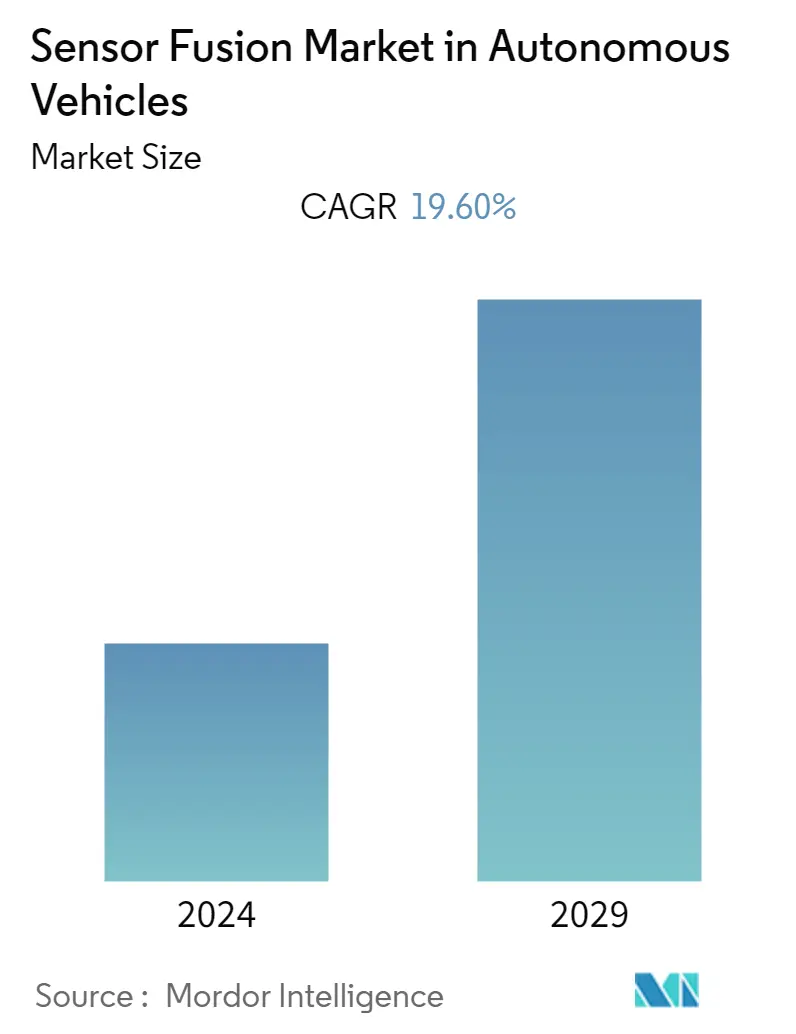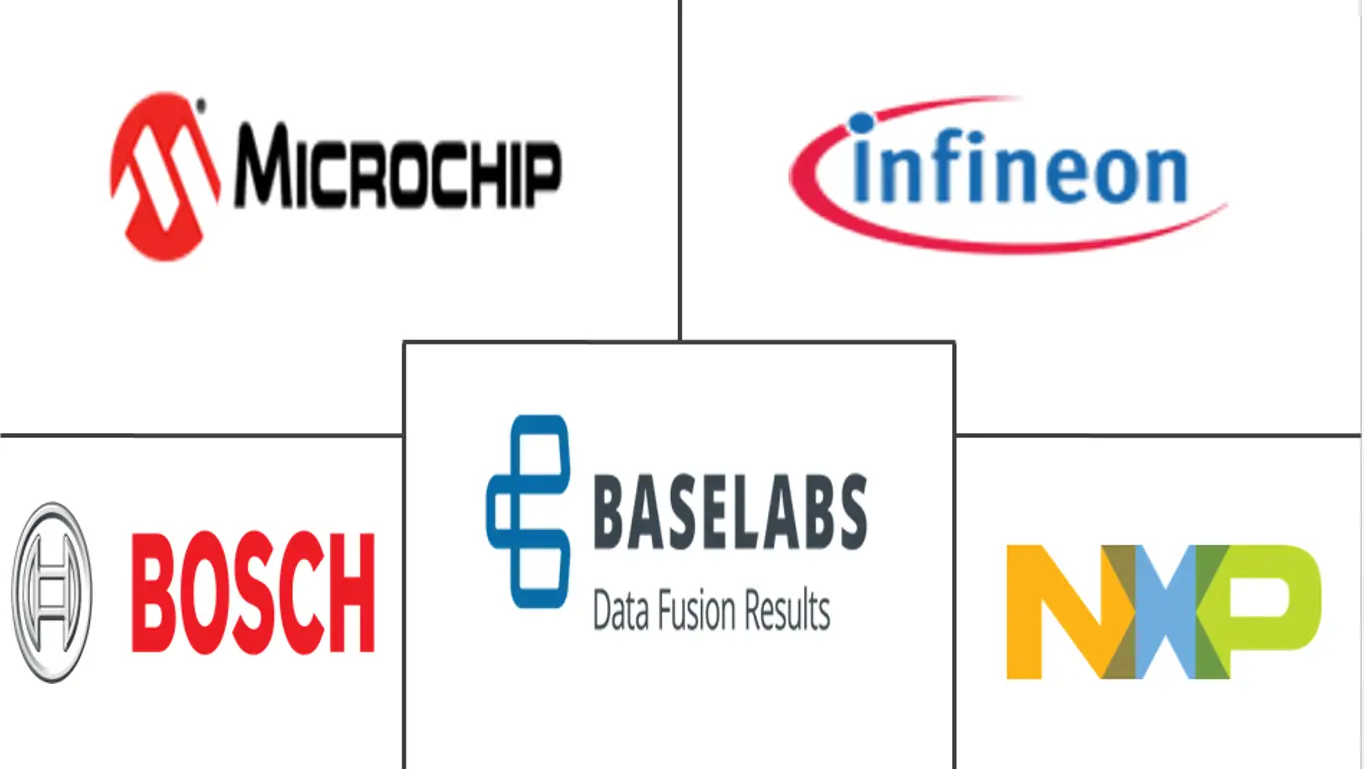Market Size of Sensor Fusion Industry in Autonomous Vehicles

| Study Period | 2019 - 2029 |
| Base Year For Estimation | 2023 |
| CAGR | 19.60 % |
| Fastest Growing Market | Asia Pacific |
| Largest Market | North America |
| Market Concentration | Medium |
Major Players
*Disclaimer: Major Players sorted in no particular order |
Autonomous Vehicles Sensor Fusion Market Analysis
The sensor fusion market in autonomous vehicles is expected to grow by registering a CAGR of 19.6% during the forecast period. The growing trend of including advanced functionalities in autonomous vehicles, such as advanced driver assistance systems (ADAS), new radar systems, cameras, lidar, and GNSS sensors enhanced the requirements of flexible systems to quickly and safely detect the variables and respond, which is also among the significant factors driving the growth of sensor fusion in the autonomous vehicle sector.
- Resolving contradictions between sensors, synchronizing sensors, predicting the future positions of objects, and achieving automated driving safety requirements are some of the primary objectives of sensor fusion in an autonomous vehicle application. According to the World Economic Forum, more than 12 million fully autonomous cars are expected to be sold annually by 2035. Autonomous vehicles will account for 25% of the global automotive market. According to Intel, a single autonomous vehicle can generate an average of 4 terabytes of data per day. Sens fusion solutions can play a significant role in utilizing this massive data in real time.
- The growing development in ADAS and increasing utilization of the principle of GPS-IMU (Inertial Measurement Unit) fusion helps solve accumulated errors of dead reckoning in intervals with absolute position readings. Tesla's Autopilot automated driving feature is an example of an ADAS that can perform functions such as keeping the vehicle center in a highway lane by determining its precise position from data collected from a forward-facing camera and sensors.
- Collaboration between automotive and software companies is a common trend in the market. For instance, in April 2021, RoboSense, a lidar sensor provider, formed a partnership with Banma Network Technology, an intelligent automobile operating system and solution provider, and AutoX, China's leading robotaxi operator, to build a high-level autonomous driving platform for intelligent vehicles. The partnership was established primarily to promote the integration of intelligent cockpits with autonomous driving systems through the fusion of AI Capabilities, hardware, and software.
- Stringent government regulations globally also fuel the demand for the products in the market studied. For instance, Euro NCAP (European New Car Assessment Program) mandates the deployment of at least one driver assistance system. Countries like Japan and the United States also adopt similar criteria in their national NCAP rules.
- The growing safety issue of autonomous technology can not only limit the adoption of autonomous vehicles but could claim the authenticity of sensor fusion solutions. Standardization is one of the factors hindering the evolution of sensor fusion systems. Without global standards, the level of complexity of devices and ICs is expected to increase exponentially.
- The COVID-19 outbreak increasingly affected the automotive sector globally. Due to reduced outdoor activities, the demand for automobiles declined significantly, primarily during the initial phase of the pandemic. Furthermore, the reduced supply of automotive parts and shutdown of production facilities fell the working capital of automobile manufacturers, resulting in a delay or reduction in investments in new technologies. However, with the automotive sector recovering from the pandemic, new opportunities are on the horizon for sensor fusion solution providers.
Autonomous Vehicles Sensor Fusion Industry Segmentation
Sensor fusion is merging data from multiple sensors to reduce the amount of uncertainty involved in a robot navigation motion or task performing. These sensors include cameras, radar, LiDAR, Time-of-Flight (ToF), microphones, and inertial measurement units (IMU). The three fundamental ways of combining sensor data are redundant, complementary, and coordinated.
The study includes an in-depth analysis of the sensor fusion systems in the autonomous vehicle sector. A comprehensive analysis of market trends and future opportunities, along with the impact analysis of COVID-19, has also been included in the study's scope. Sensor Fusion Market in Autonomous Vehicles is Segmented by Types of Vehicles (Passenger Cars, Light Commercial Vehicles (LCV), Heavy Commercial Vehicles (HCV)) and Geography. The market sizes and forecasts are provided in terms of value (USD) for all the above segments.
| By Types of Vehicle | |
| Passenger Cars | |
| Light Commercial Vehicle (LCV) | |
| Heavy Commercial Vehicle (HCV) | |
| Other Autonomous Vehicles |
| By Geography | |
| North America | |
| Europe | |
| Asia-Pacific | |
| Latin America | |
| Middle East & Africa |
Sensor Fusion Market in Autonomous Vehicles Size Summary
The autonomous vehicles sensor fusion market is poised for significant expansion, driven by the increasing integration of advanced functionalities such as ADAS, radar systems, cameras, lidar, and GNSS sensors. These technologies necessitate flexible systems capable of swiftly and safely detecting variables and responding accordingly, which is a key factor propelling market growth. The primary objectives of sensor fusion in autonomous vehicles include resolving sensor contradictions, synchronizing sensors, predicting object positions, and ensuring automated driving safety. The market is further bolstered by collaborations between automotive and software companies, as well as stringent government regulations mandating the deployment of driver assistance systems. Despite challenges such as safety concerns and the lack of global standards, the market is expected to benefit from the recovery of the automotive sector post-COVID-19, with new opportunities emerging for sensor fusion solution providers.
North America stands out as a major hub for the sensor fusion market in autonomous vehicles, with the United States leading in ADAS-enabled vehicles and self-driven transportation solutions. The region's economic growth and high domestic consumption, coupled with significant exports, contribute to the market's expansion. Canada also shows a growing acceptance of autonomous cars, encouraging increased investments from automobile manufacturers. The market is moderately competitive, with both established companies and new entrants focusing on developing affordable and advanced sensor fusion technologies. Recent advancements, such as MicroVision's dynamic view lidar system and Qualcomm's Snapdragon Ride Vision System, highlight the ongoing innovation in the sector. These developments, along with strategic acquisitions and partnerships, are expected to drive the adoption of sensor fusion solutions in autonomous vehicles, enhancing safety and functionality.
Sensor Fusion Market in Autonomous Vehicles Market Size - Table of Contents
-
1. MARKET INSIGHTS
-
1.1 Market Overview
-
1.2 Industry Attractiveness - Porter's Five Forces Analysis
-
1.2.1 Bargaining Power of Suppliers
-
1.2.2 Bargaining Power of Buyers
-
1.2.3 Threat of New Entrants
-
1.2.4 Intensity of Competitive Rivalry
-
1.2.5 Threat of Substitute Products
-
-
1.3 Industry Value Chain Analysis
-
1.4 Technology Snapshot
-
1.5 Impact of COVID-19 on the Market
-
-
2. MARKET SEGMENTATION
-
2.1 By Types of Vehicle
-
2.1.1 Passenger Cars
-
2.1.2 Light Commercial Vehicle (LCV)
-
2.1.3 Heavy Commercial Vehicle (HCV)
-
2.1.4 Other Autonomous Vehicles
-
-
2.2 By Geography
-
2.2.1 North America
-
2.2.2 Europe
-
2.2.3 Asia-Pacific
-
2.2.4 Latin America
-
2.2.5 Middle East & Africa
-
-
Sensor Fusion Market in Autonomous Vehicles Market Size FAQs
What is the current Autonomous Vehicles Sensor Fusion Market size?
The Autonomous Vehicles Sensor Fusion Market is projected to register a CAGR of 19.60% during the forecast period (2024-2029)
Who are the key players in Autonomous Vehicles Sensor Fusion Market?
ROBERT BOSCH GMBH, Infineon Technologies AG , BASELABS GMBH , NXP Semiconductors NV and Microchip Technology Inc. are the major companies operating in the Autonomous Vehicles Sensor Fusion Market.

